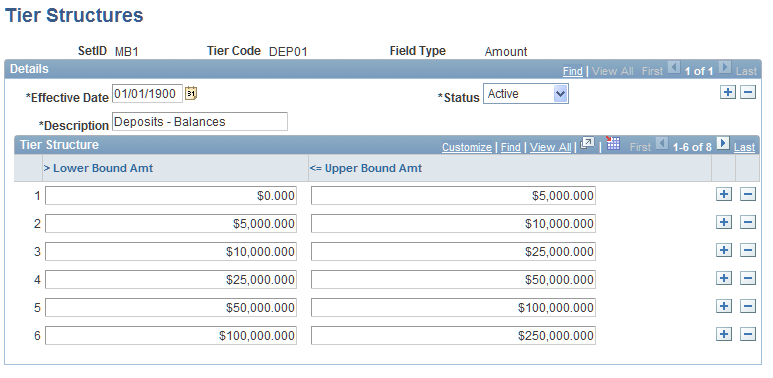Setting Up Tier Structures
An alternative to incremental grouping is to group according to tiers. You can use tiers on numbers, amounts, and rate fields. The main difference between using tiers and increments is that you can define the specific tiers that you want to stratify the data into to match business logic, reporting requirements, or both. Tiers also give you more control in terms of limiting the number of strata created for any given attribute to only ranges that are pertinent for processing or reporting purposes. For example, you could define a rule that groups the initial balance amounts in increments of 10,000. However, this could result in hundreds of strata if the balance amounts range anywhere from 1 to 100,000,000. A more efficient and logical way to group balance amounts may be to set up tiers so that the first tier contains amounts between 1 and 50,000; the second tier contains amounts between 50,000 and 1,000,000; and the third tier contains amounts between 1,000,000 and 100,000,000. Tiers are ideal for handling balance amounts.
Page Used to Set Up Tier Structure
|
Page Name |
Definition Name |
Navigation |
Usage |
|---|---|---|---|
|
Tier Structures |
FI_TIER_STRUCTURE |
|
Stratify source data into a finite number of pools that are used by the Stratification Reporting Rules - Group By page. |
Tier Structures Page
Use the Tier Structures page (FI_TIER_STRUCTURE) to stratify source data into a finite number of pools that are used by the Stratification Reporting Rules - Group By page.
Image: Tier Structures page
This example illustrates the fields and controls on the Tier Structures page. You can find definitions for the fields and controls later on this page.

Set the lower- and upper-bound amounts for the tiers. The lower-bound range must be greater than the lower-bound amount. The upper-bound range must be less than or equal to the upper-bound amount. These values do not overlap. To accommodate extreme values, the Stratification application engine automatically creates ranges on both the upper and lower sides of the user-defined tiers.
Note: To use tiers, ensure that TIER is a valid code on the Operation Codes - Amounts page for the selected field type.